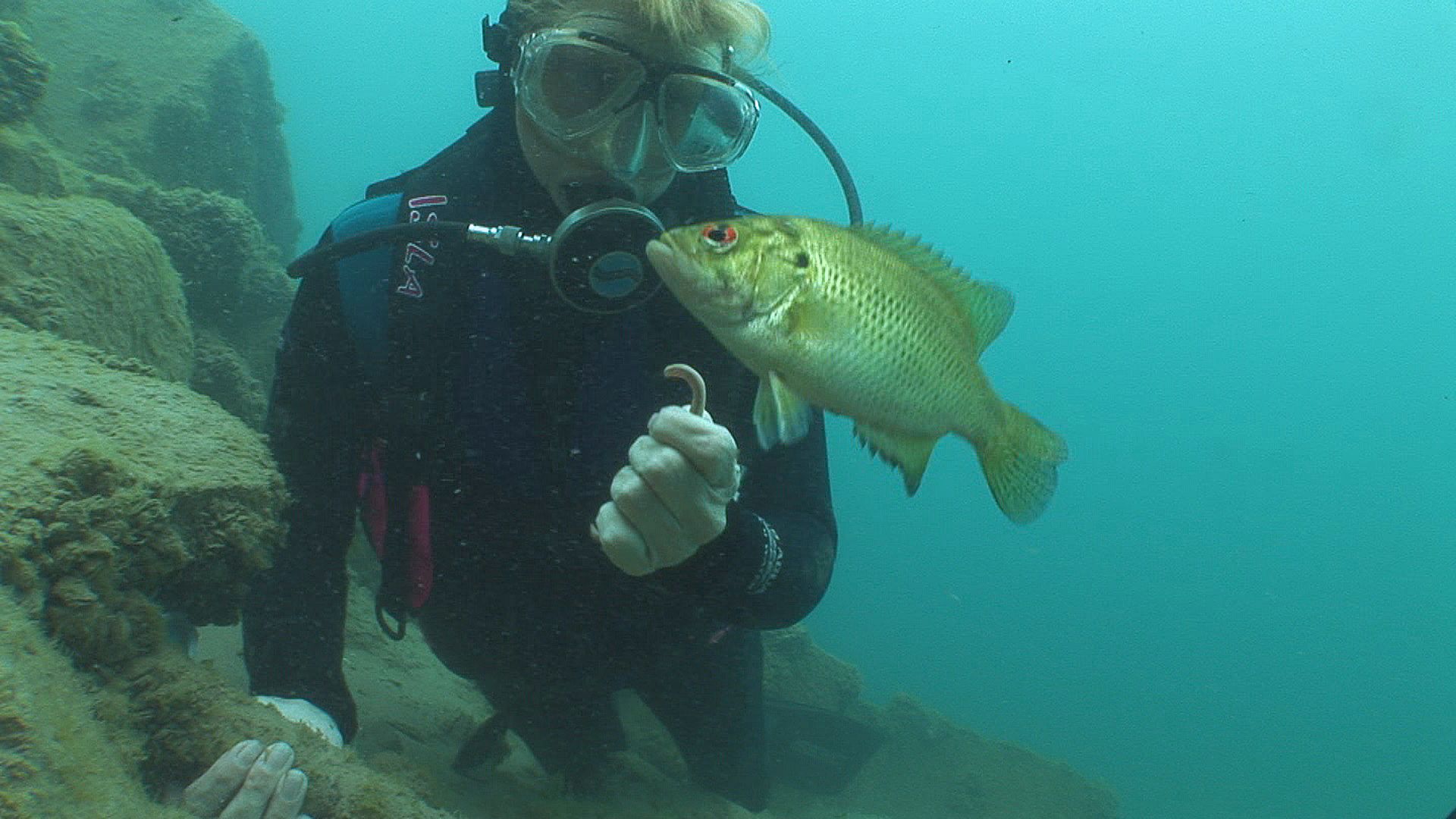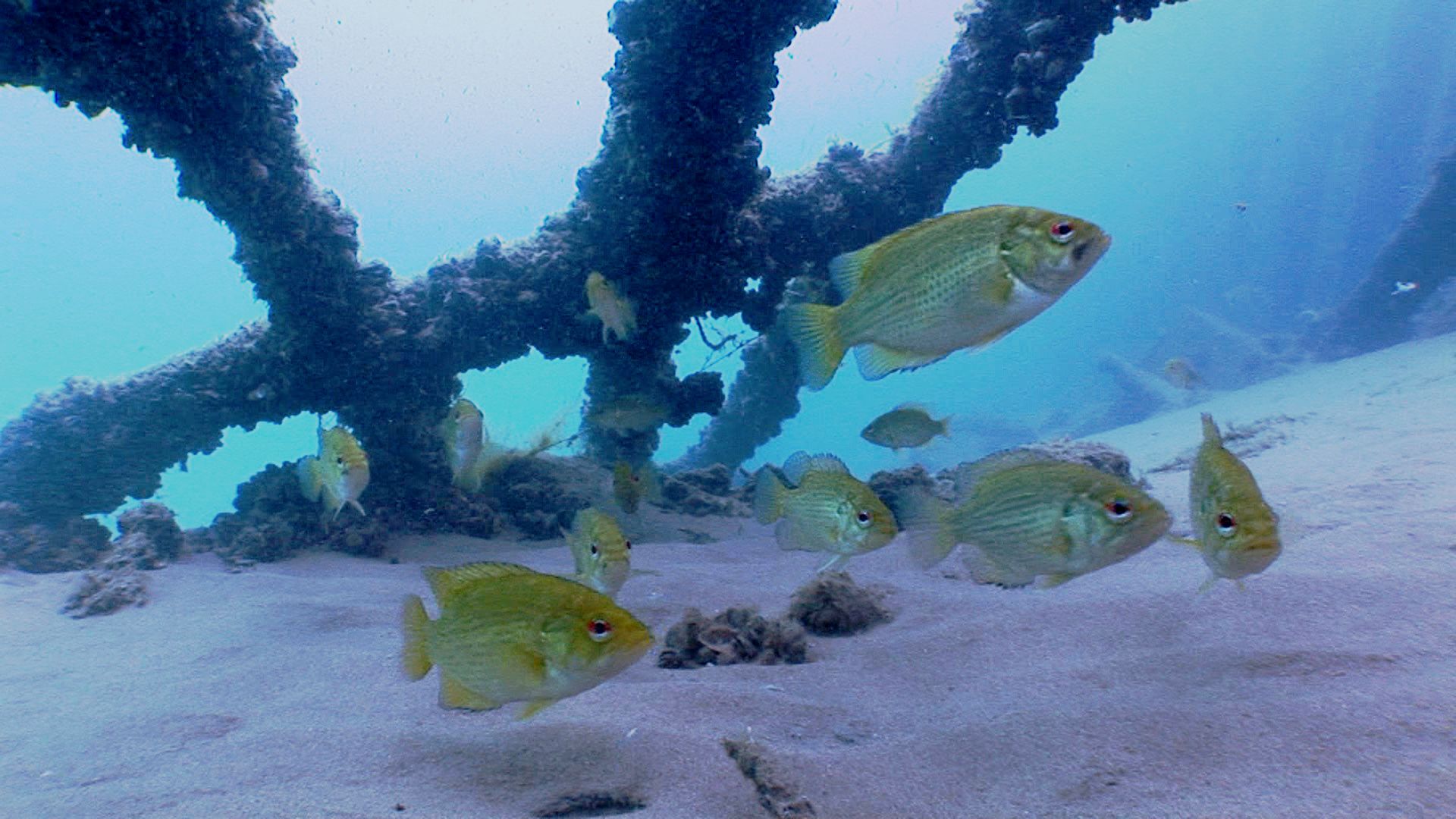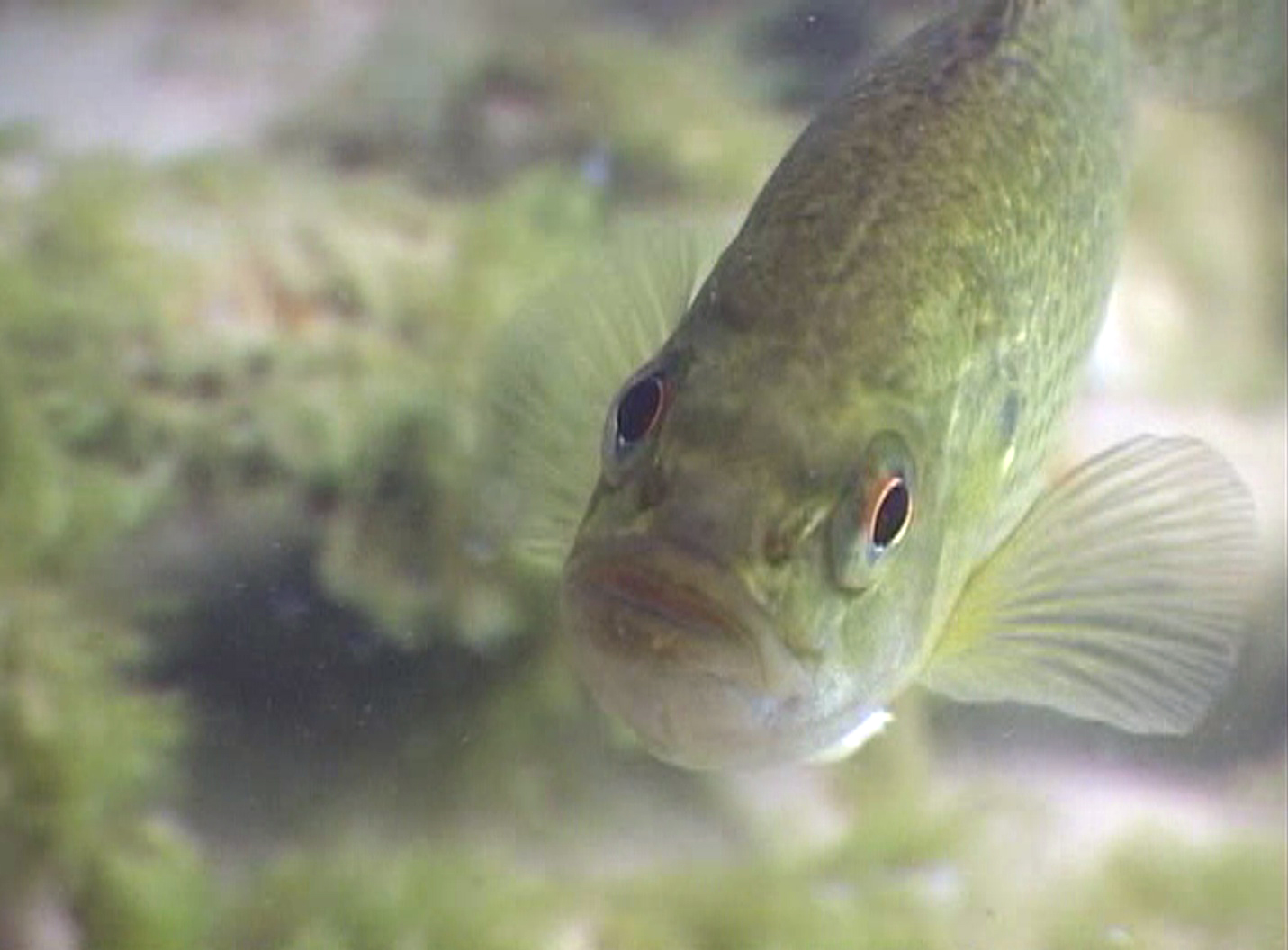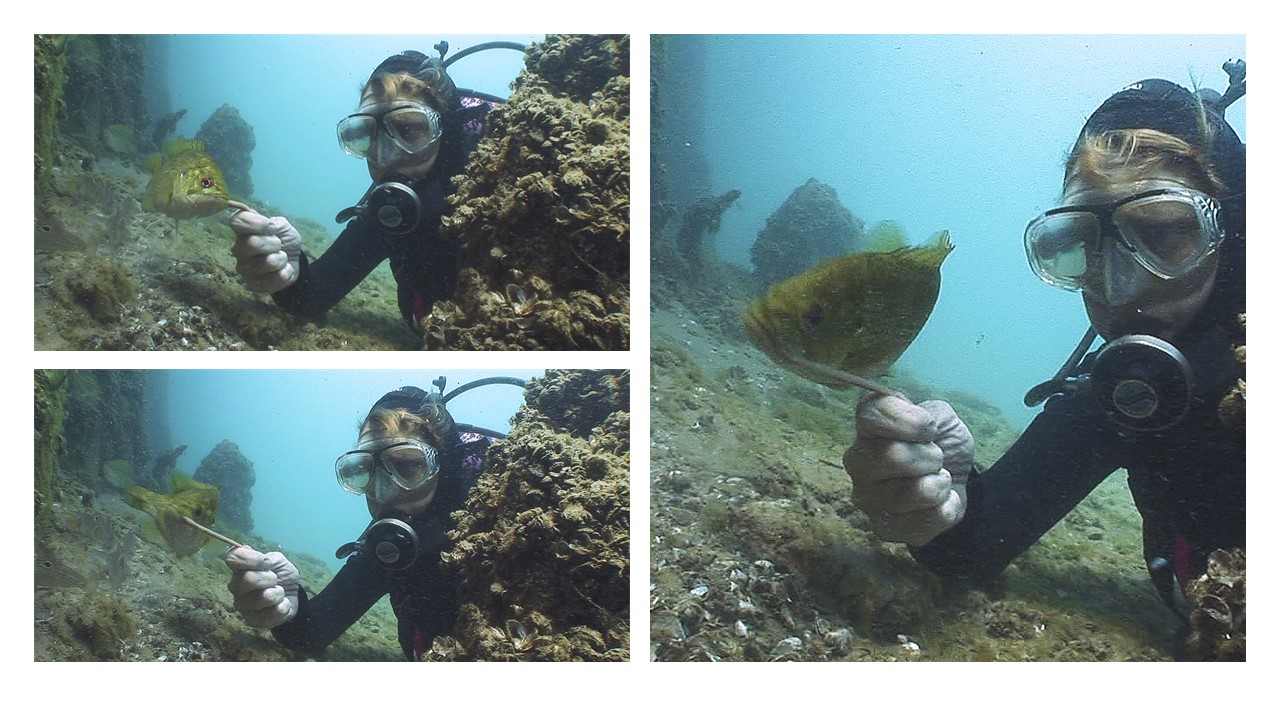
 I Speak for the Fish is a monthly column written by Great Lakes Now Contributor Kathy Johnson, coming out the third Monday of each month. Publishing the author’s views and assertions does not represent endorsement by Great Lakes Now or Detroit Public Television. Check out her previous columns.
I Speak for the Fish is a monthly column written by Great Lakes Now Contributor Kathy Johnson, coming out the third Monday of each month. Publishing the author’s views and assertions does not represent endorsement by Great Lakes Now or Detroit Public Television. Check out her previous columns.
One of my favorite kinds of bass isn’t even a bass at all.
Rock bass are also known as red eye, google eye, black perch, and rock perch, but they are actually a type of sunfish. At least that’s the family reunion they would attend, albeit at the cousins’ table.
Like most sunfish, rock bass tend to prefer slower-moving water. When diving, I typically find them around piling clusters, inside drainpipes, or clustered under any kind of overhead shelter.
Rock bass like to school, so I rarely see just one. Small schools of 3 or 4 individuals are common, while an ideal spot under a deeply shaded dock could shelter 3 or 4 dozen fish.
Occasionally, I’ll see one tagging along with a couple of smallmouth bass. But the rock bass cannot hang with the bigger fish for long.
Sunfish rely primarily on their pectorals to maneuver. Pectorals are the little fins on each side of their body. They can twirl around like an Olympic figure skater, but I could probably beat them to the other end of an Olympic swimming pool.
Rock bass are stronger swimmers than most sunfish, but they could never keep up with smallmouth, who use their powerful bodies and tail fins to achieve speeds that I think Michael Phelps might envy.
En Garde

A small school of rock bass shelter under some quagga mussel-covered logs. (Photo Credit: Greg Lashbrook/PolkaDot Perch)
Rock bass need to be 3 to 5 inches long or 2 to 3 years old before spawning. They spawn during the day, typically starting in the morning.
Spawning begins in the late spring when the water temperature reaches 60 degrees. Males move into the spawning areas a few days ahead of the females to prepare the nest sites.
Like all sunfish, male rock bass create and guard circular nests. The males use their fins to fan out nests that can measure up to 2 feet in diameter and several inches deep.
There is often a lot of competition for the best locations. The ideal nest site has a loose gravel bottom and is close to some kind of structure like a grass bed or a log jam.
Large numbers of fish may gather in one area, and nest sites are often placed fairly close together. The nests are clustered together, in part, to make it easier for the females to find them but this concentration of ripe males creates a lot of tension as each defends their chosen spot.
Unlike male bluegill which perform a shimmying rumba to catch the attention of a female, male rock bass don’t bother with elaborate courtship displays.
The females arrive and peruse the nesting grounds. When they find an available male and nest site to their liking, they will drop in and join the male near the bottom.
The pair will come together and swim belly to belly in a tight circle as the eggs and sperm are released. The fertilized eggs drop down into the loose gravel at the bottom of the nest. Spawning may last for nearly an hour, with upwards of 5000 eggs deposited by each female.
The female may leave voluntarily when she is done, or sometimes, the male will drive her from the nest before she has released all of her eggs. In that case, she will visit another nest site to finish spawning. This is because males try to spawn with multiple females.
“Spent” females leave the nesting grounds once they are done laying their eggs.
The males remain on their nest sites for many weeks. First protecting and aerating the eggs and then guarding the fry after hatching to give them the best chance of surviving.
Nest guarding species are often very successful at reproducing, which can quickly create imbalances in systems. Rock bass are one species that has been known to overpopulate small lakes.
The Royal Ontario Museum Field Guide to Freshwater Fishes of Ontario notes that where rock bass are native, they are not a problem. But where they are introduced, they often become too abundant while other native species decline as a result of competition for food.
Haute Couture

Rock bass are easily identified by their bright red eyes. (Photo Credit: Greg Lashbrook/PolkaDot Perch)
A lot of fish change color when they are spawning or nest guarding, and I think it’s cool that rock bass can change color to match their surroundings.
Metachrosis, or the physical changing of color, is more commonly associated with saltwater species like octopus. But freshwater species benefit from camouflage, too. It’s just not as showy when a rock bass darkens itself to virtually disappear in the shadows versus a cuttlefish morphing into the coral.
As their alternate names infer, the rock bass’ eye color can range from deep scarlet to fiery orange.
Their upper bodies are a deep bronzy green with broad stripes on their backs that extend vertically down each side. Their scales have a dark spot at the base, which creates a linear pattern of dots running down their sides.
Like 18th century fashionistas who first sported black dots on their cheeks, rock bass have a distinctive dark-blue beauty spot on the tips of their gill covers. Their bellies are a soft milky white.
How big they get depends, to a large degree, on where they live. Rock bass’ growth is often stunted in streams, while large lakes produce larger fish.
By the fall of their first year, most will still only be about one inch long. At one year, they are still just 1 to 3 inches long. Mature adults can reach up to 12 inches, but most will max out somewhere between 4 to 8 inches. Average life span is 5 to 10 years.
Open Buffet

I Speak For The Fish columnist Kathy Johnson hand feeds a nightcrawler to a rock bass in the St Clair River. (Photo Credit: Greg Lashbrook/PolkaDot Perch)
One of my favorite books is The Fishes of Ohio by Milton Trautman. It is a great historical reference because it documents Ohio’s fishery from the early 1800s through 1980.
I particularly enjoy the way Trautman includes personal anecdotes to illustrate the changing fishery.
Trautman owned a home on South Bass Island in Western Lake Erie, and before 1944, on late June evenings, he could see hundreds of rock bass rising to the surface to feast on mayflies. After 1948, he would only see a dozen fish during the same time period.
Trautman attributes the decline of the rock bass to the near disappearance of two large species of mayfly which the fish historically gorged themselves on. Pollution and the widespread use of pesticides contributed to the loss of the mayflies.
Young rock bass feed on the tiniest of aquatic organisms and gradually transition to insects and crustaceans as they grow larger.
The adult diet varies depending on season and location but they usually hunt near the bottom for crayfish and small crustaceans like scuds. They will also take minnows or other small bait fish and insects like mayflies near the surface.
They also really like nightcrawlers.
I have tried to hand-feed a lot of different species. Some will take the food immediately and others want nothing to do with me. Rock bass are fun to feed. They remind me of 10-month-old golden retrievers: cute, energetic and super playful.
Although rock bass have a large mouth for their size, their bite is not terribly strong. Instead of chomping off a piece of nightcrawler like trout, the rock bass will grab ahold of the worm and pull until it snaps.
One particularly stretchy worm doubled in length before breaking! But the fish won the tug-of-war, and its prize was to swim away with the bigger piece.
Catch more news at Great Lakes Now:
I Speak for the Fish: Bringing muskie to the masses
I Speak for the Fish: The great seasonal flip
Featured image: I Speak For The Fish columnist Kathy Johnson hand feeds a nightcrawler to a rock bass in the St Clair River. (Photo Credit: Greg Lashbrook/PolkaDot Perch)
1 Comment
-
In the Niagara River there was a drastic decline of rock bass largely due to the effects of the ice boom. Google Joe Barrett ice boom for the truth on the harm done to the entire lower Great Lakes ecosystem by the ice boom




